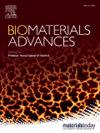Erythrocyte membrane vesicles as drug delivery systems: A systematic review of preclinical studies on biodistribution and pharmacokinetics
IF 5.5
2区 医学
Q2 MATERIALS SCIENCE, BIOMATERIALS
Materials Science & Engineering C-Materials for Biological Applications
Pub Date : 2025-02-14
DOI:10.1016/j.bioadv.2025.214234
引用次数: 0
Abstract
This systematic review aims to summarize the development of erythrocyte membrane vesicles (EMVs) as drug delivery carriers, with a focus on elucidating their fate in terms of biodistribution and pharmacokinetics in preclinical studies. The PubMed database was systematically reviewed to search for original peer-reviewed published studies on the use of EMVs for drug delivery to summarize the preclinical findings, following the PRISMA guidelines. A total of 142 articles matched the selection criteria and were included in the review. For each study, the following parameters were extracted: type of active pharmaceutical ingredient (API) encapsulated into EMVs, EMVs-API formulation method and final particle size, EMVs surface modifications for active targeting, cell lines and animal models used in the study, crucial treatment data, biodistribution data and finally, where applicable, data about the EMVs circulation time and blood half-life. EMVs size did not vary significantly among the different formulation methods. A complete list of cell lines and animal models used is provided. Circulation times and data for blood half-life were grouped per animal type. For the most commonly used animal type, BALB/c mice, the average half-life of EMV-API was calculated to be 10.4 h, and in all cases, up to a 10-fold increase was observed compared with that of free API. Surface modifications did not drastically change the circulation time but did improve target tissue accumulation. The most critical weaknesses in the analysed studies were identified. Key points for future studies are provided to fill the current knowledge gaps and improve the quality of publications.

求助全文
约1分钟内获得全文
求助全文
来源期刊
CiteScore
17.80
自引率
0.00%
发文量
501
审稿时长
27 days
期刊介绍:
Biomaterials Advances, previously known as Materials Science and Engineering: C-Materials for Biological Applications (P-ISSN: 0928-4931, E-ISSN: 1873-0191). Includes topics at the interface of the biomedical sciences and materials engineering. These topics include:
• Bioinspired and biomimetic materials for medical applications
• Materials of biological origin for medical applications
• Materials for "active" medical applications
• Self-assembling and self-healing materials for medical applications
• "Smart" (i.e., stimulus-response) materials for medical applications
• Ceramic, metallic, polymeric, and composite materials for medical applications
• Materials for in vivo sensing
• Materials for in vivo imaging
• Materials for delivery of pharmacologic agents and vaccines
• Novel approaches for characterizing and modeling materials for medical applications
Manuscripts on biological topics without a materials science component, or manuscripts on materials science without biological applications, will not be considered for publication in Materials Science and Engineering C. New submissions are first assessed for language, scope and originality (plagiarism check) and can be desk rejected before review if they need English language improvements, are out of scope or present excessive duplication with published sources.
Biomaterials Advances sits within Elsevier''s biomaterials science portfolio alongside Biomaterials, Materials Today Bio and Biomaterials and Biosystems. As part of the broader Materials Today family, Biomaterials Advances offers authors rigorous peer review, rapid decisions, and high visibility. We look forward to receiving your submissions!

 求助内容:
求助内容: 应助结果提醒方式:
应助结果提醒方式:


